Helping students think creatively is one of the most valuable things you can encourage in your classroom.
Whether they are preparing for a project, exploring a new topic, or solving a real-world problem, students need time and space to generate ideas freely.
This is where brainstorming activities become essential. They help students explore different possibilities, work collaboratively, and push their thinking beyond the obvious.
TLDR; Brainstorming Activities in the Classroom
Brainstorming helps students unlock ideas, think more creatively, and collaborate with confidence. If you need a quick overview of all the brainstorming activities covered in this guide, here’s everything at a glance:
| Category | Example | Objective |
|---|---|---|
| Visual Brainstorming Activities | Mind Mapping, Sketch to Stretch, Concept Posters, Visual Webbing | Helps students see connections and organize ideas visually |
| Collaborative Brainstorming Activities | Round Robin Sharing, Group Idea Board, Team Carousel, Idea Relay | Builds shared thinking and ensures all students contribute |
| Fast-Paced Brainstorming Activities | Rapid Listing, Lightning Rounds, One-Minute Words, Flash Brainwriting | Encourages spontaneous thinking and quick ideation |
| Movement-Based Brainstorming Activities | Station Rotation Ideas, Idea Walk, Gallery Walk, Four Corners | Energizes students through physical movement and station work |
| Writing-Centered Brainstorming Activities | Brainwriting 6-3-5, Freewriting, Question Storming, Sticky Note Dumps | Supports reflection, silent ideation, and independent thinking |
| Problem-Solving Brainstorming Activities | SCAMPER, Reverse Brainstorming, Five Whys, Cause and Effect Diagramming | Helps students analyze challenges and generate solutions |
| Digital Brainstorming Activities | Digital Word Clouds, Collaborative Boards, Live Polls, Anonymous Submissions | Word clouds, collaborative boards, live polls, anonymous submissions |
What is Brainstorming and Why It Matters
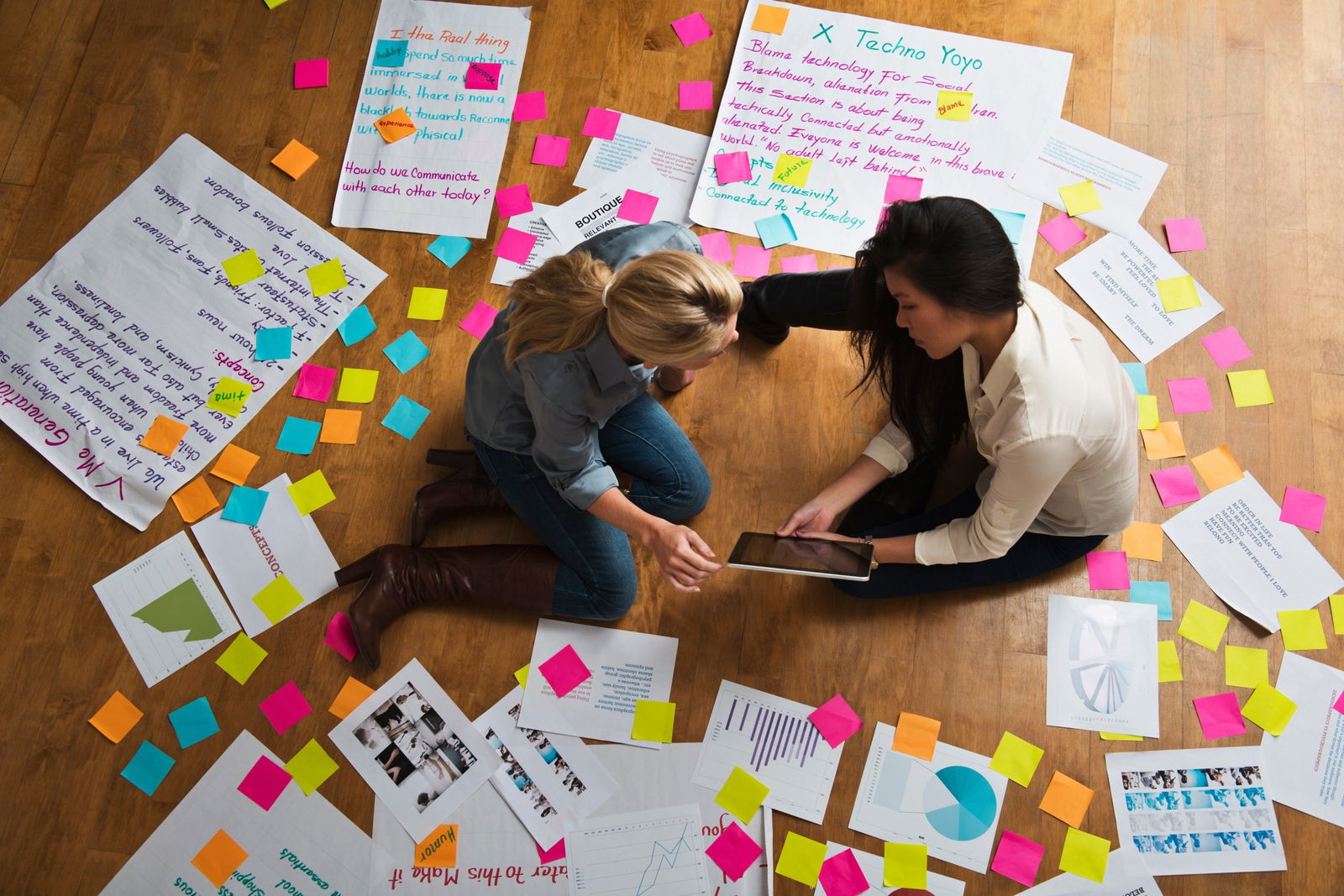
Brainstorming is a structured yet open-ended process where students generate as many ideas as possible without immediately judging or filtering them.
Instead of trying to get the right answer quickly, students are encouraged to explore all possible angles. This process supports creativity, critical thinking, and deeper understanding across subjects.
Why Brainstorming Matters in the Classroom
Brainstorming plays a vital role in learning. It helps students develop flexible thinking, share unique perspectives, and feel more confident participating in class.
It also strengthens communication and problem-solving skills, since students learn to build on each other’s ideas and refine them collaboratively.
When students see that their contributions matter, they become more engaged and willing to take intellectual risks.
Steps for Running an Effective Brainstorming Session

A smooth brainstorming session requires structure. You can follow these steps for any grade level or subject:
1. Set the goal
Provide a clear question, prompt, or challenge to guide student thinking.
2. Warm up the room
Start with a simple, low-stakes prompt to get ideas flowing.
3. Share guidelines
Remind students that all ideas are welcome and evaluation comes later.
4. Choose the right activity
Use a brainstorming format that matches your purpose, class dynamics, and available time.
5. Gather ideas
Give students uninterrupted time to contribute ideas without filtering.
6. Organize and cluster
Group similar ideas together and identify patterns or emerging themes.
7. Decide what comes next
Select promising ideas and connect them with upcoming tasks, research, or projects.
Below are seven major categories of brainstorming activities, each with multiple strategies that work across different subjects and grade levels:
Visual Brainstorming Activities
These activities support visual learners and help students understand how ideas connect.

1. Mind Mapping
Students start with a central concept and draw branches that represent supporting details, examples, or related ideas. This visual model helps them break down complex topics, study relationships, and plan writing or research.
2. Sketch to Stretch
Students sketch what comes to mind when they read a passage, analyze a process, or explore a new topic. The goal is to turn abstract ideas into visual form. This helps students see meaning differently and encourages creative interpretation.
3. Concept Posters
Groups create posters filled with diagrams, symbols, keywords, and short explanations. These posters can show processes, summaries, or connections. They work well after an initial round of brainstorming to refine and display ideas.
4. Visual Webbing
Students use shapes, lines, and arrows to illustrate relationships. They might show causes and effects, character relationships, or parts of a system. This strengthens visual reasoning and helps students make structured sense of content.
Collaborative Group Brainstorming Activities
These activities encourage teamwork, build confidence, and expose students to multiple perspectives.

5. Round Robin Sharing
Students sit in groups and take turns sharing an idea one at a time. The structure ensures everyone contributes, including shy students, and gives equal weight to each voice in the room.
6. Group Idea Board
Students write ideas on sticky notes and add them to a shared board. The group sorts them into categories, removes duplicates, and identifies themes. This helps students see patterns and build a collective understanding.
7. Team Carousel
Groups rotate through stations with different prompts. They add new ideas or expand on the ideas left by previous groups. This creates momentum and encourages interaction with diverse viewpoints.
8. Idea Relay
Students pass an idea sheet along a line, with each person adding or adjusting an idea before passing it on. This creates a chain of collaborative thinking and builds ideas through multiple perspectives.
Fast-Paced Brainstorming Activities
These activities energize the classroom and encourage quick, spontaneous thinking.

9. Rapid Listing
Students list as many ideas as possible within a one to two minute time limit. The time pressure helps students bypass overthinking and generate raw, creative ideas.
10. Lightning Round
Students respond instantly to quick prompts, either in pairs or small groups. This is useful as a warm-up or to break mental blocks.
11. One Minute Words
Students have one minute to generate vocabulary or related concepts connected to a topic. This is especially useful in language classes and science units.
12. Flash Brainwriting
Students quickly write an idea on paper and pass it to a classmate who adds another. This cycle continues for several rounds, allowing collective idea-building at high speed.
Movement-Based Brainstorming Activities
These activities help students stay active and think more dynamically while contributing ideas.

13. Station Rotation Ideas
Multiple stations are set up with different questions or themes. Students rotate through the stations, contributing ideas at each one. This allows them to explore many angles of a topic.
14. Idea Walk
Prompts or images are placed around the room. Students walk around and add their responses. This keeps the session light and encourages students to think in multiple contexts.
15. Gallery Walk
Groups create posters or diagrams and display them. Other students circulate the room, leaving comments or questions. This encourages peer feedback and analysis.
16. Four Corners
Each corner represents a different idea or position. Students choose a corner, discuss why they selected it, and brainstorm supporting reasons. This works well for opinion-based or ethical discussions.
Writing-Centered Brainstorming Activities
These activities allow students to explore ideas independently before sharing with the group.

17. Brainwriting 6-3-5
Six students write three ideas in five minutes, then pass their paper to the next student. Each rotation adds new contributions. This method helps quieter students share ideas without speaking.
18. Freewriting
Students write continuously about a topic for a set period, without concern for grammar or structure. This uncovers thoughts that may not surface through structured discussion.
19. Question Storming
Students focus entirely on generating questions rather than answers. They explore all possible angles and uncertainties, which leads to richer inquiry-based learning.
20. Sticky Note Dumps
Students write one idea per sticky note and add them to a board. After the brainstorm, the class reviews the notes and organizes them into themes. This allows a high volume of ideas to surface quickly.
Problem-Solving Brainstorming Activities
These activities support critical thinking and help students tackle complex issues.

21. SCAMPER
Students reimagine a product, story, or idea by applying the SCAMPER prompts: Substitute, Combine, Adapt, Modify, Put to another use, Eliminate, Rearrange. It works well in STEM, design, and project-based learning.
22. Reverse Brainstorming
Students brainstorm how to cause or worsen a problem. Once ideas are listed, they reverse them to find real solutions. This playful approach lowers pressure and encourages creative problem-solving.
23. Five Whys
Students repeatedly ask “why” to dig into the root cause of a problem. This leads to deeper insights and helps students avoid surface-level answers.
24. Cause and Effect Diagramming
Students draw diagrams with a main problem at the center and branches representing contributing factors. This visual breakdown supports complex problem-solving and system thinking.
Digital Brainstorming Activities
These activities help gather ideas quickly and inclusively, especially for students who prefer writing over speaking.
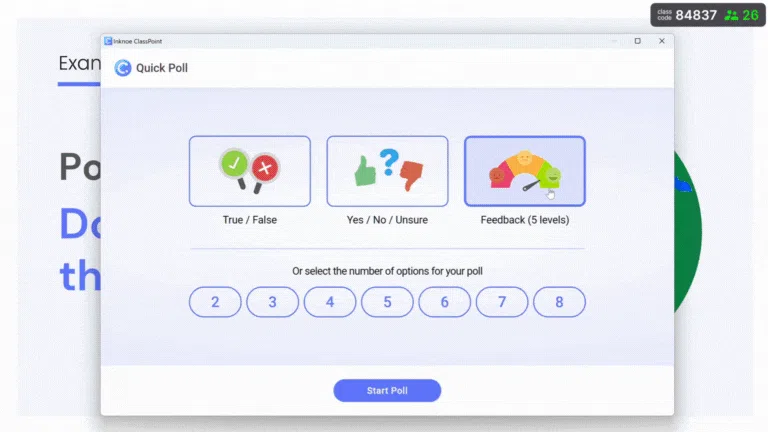
25. Digital Word Clouds
Students submit words or ideas digitally, and a collective word cloud forms. Larger words represent more common answers, helping students see shared thinking at a glance.
Use word clouds to move into deeper grouping activities. Circle the largest words and ask students why they dominated.
26. Collaborative Boards
Students post notes, images, or ideas on a shared digital space. This makes it easy to gather contributions from the entire class and see connections visually.
27. Live Polls
Students answer a prompt or question digitally, which helps teachers get instant feedback. Anonymous responses encourage honesty and participation from hesitant students.
28. Anonymous Idea Submissions
Students submit ideas without attaching their names. This helps build a safe space for honest input and encourages participation from quieter students.
How ClassPoint Makes Brainstorming Activities More Effective
Even the most effective brainstorming activities become more impactful when students can contribute ideas easily and interactively.
ClassPoint, which works directly inside PowerPoint, gives teachers simple tools to run brainstorming sessions without switching between apps.
Here is how ClassPoint supports brainstorming in the classroom:
Word Cloud
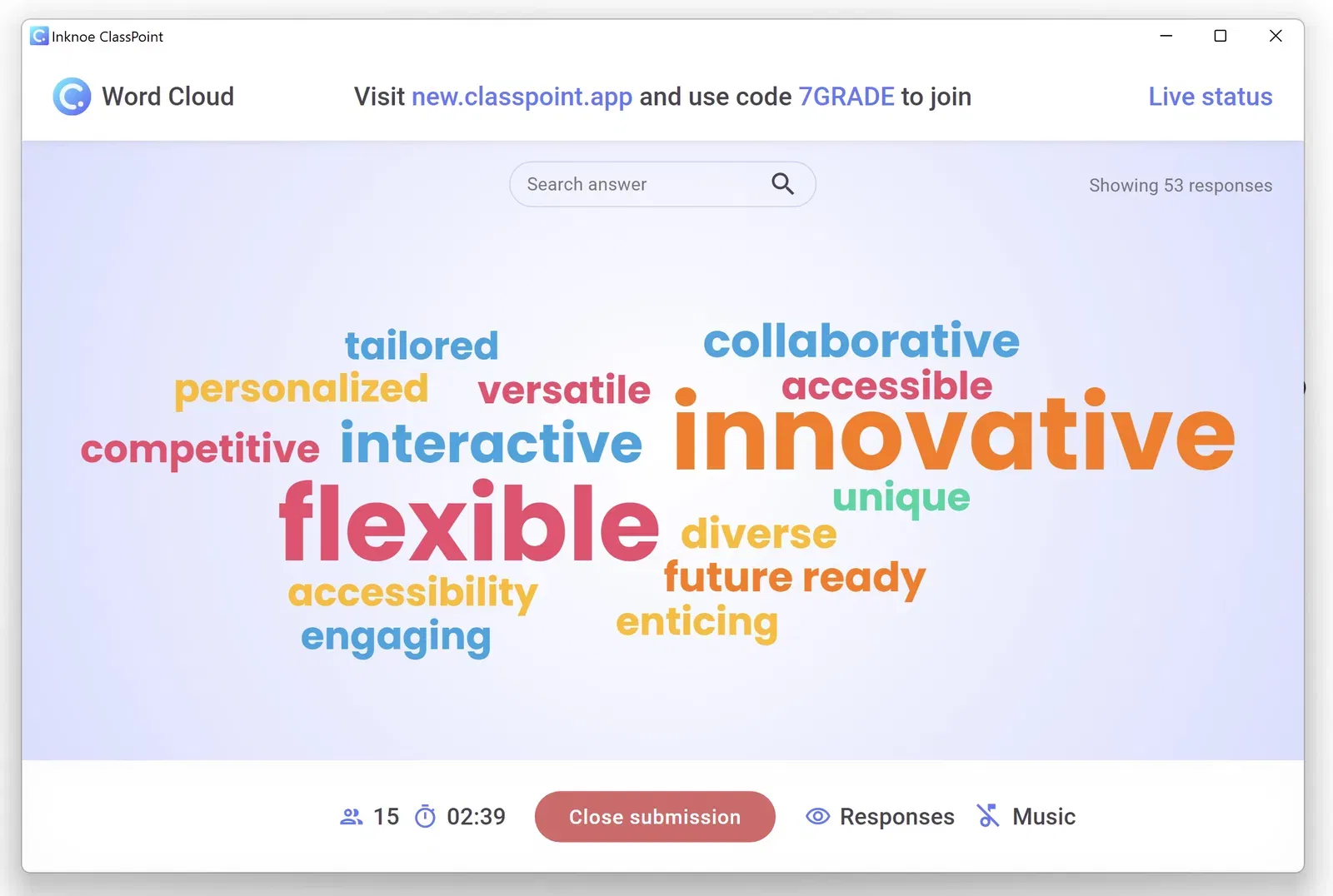
Word Cloud turns class ideas into a collective visual instantly.
It supports brainstorming by highlighting class-wide patterns instantly, encouraging fast idea contribution, and working well for warm-ups or initial ideation.
Examples:
- After reading a chapter, ask: “What emotions do you think the main character felt?”
- For science: “List all energy sources you know.”
- For social studies: “What comes to mind when you hear the word ‘migration’?”
Short Answer
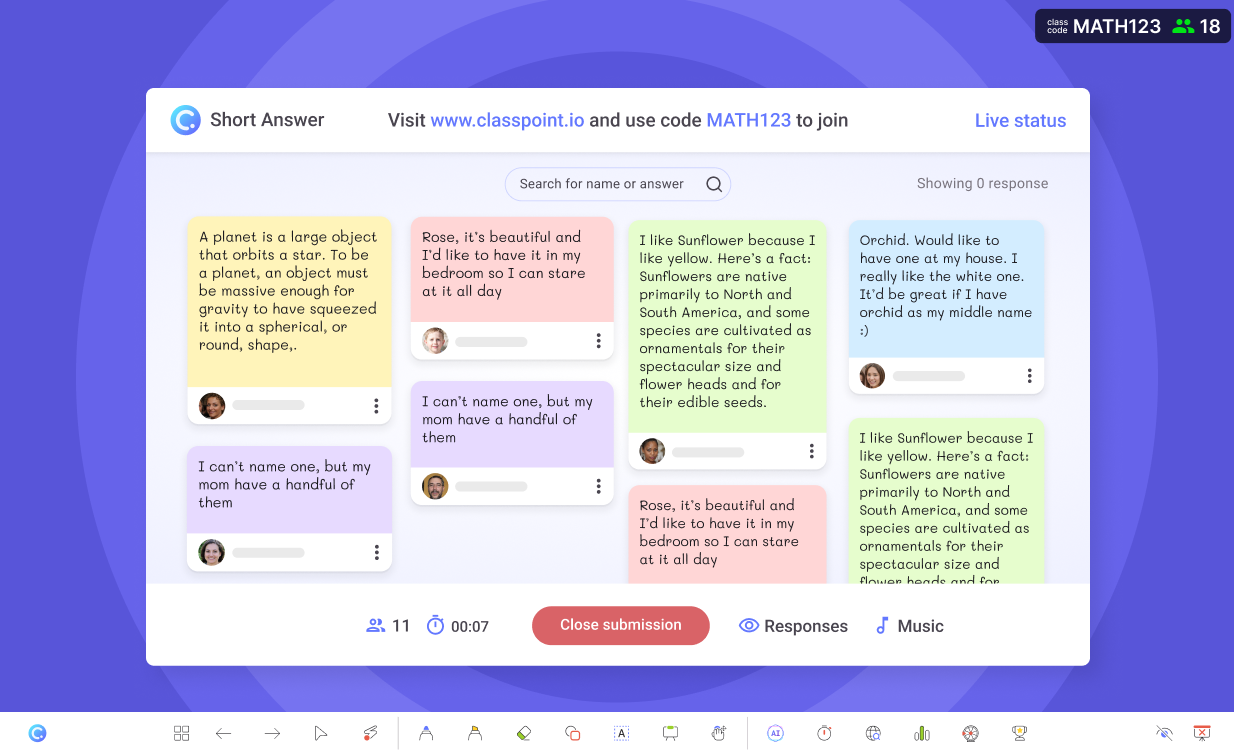
Short Answer lets students submit detailed thoughts or multiple ideas at once.
How it supports brainstorming:
- Allows detailed explanations
- Encourages thoughtful responses
- Supports quiet students who prefer writing
Ask students to submit multiple ideas. Then click “Select Top Responses” to highlight the strongest contributions.
Running out of Short Answer questions? Check out 100+ Short Answer Questions Across Bloom’s Taxonomy Levels.
Image Upload
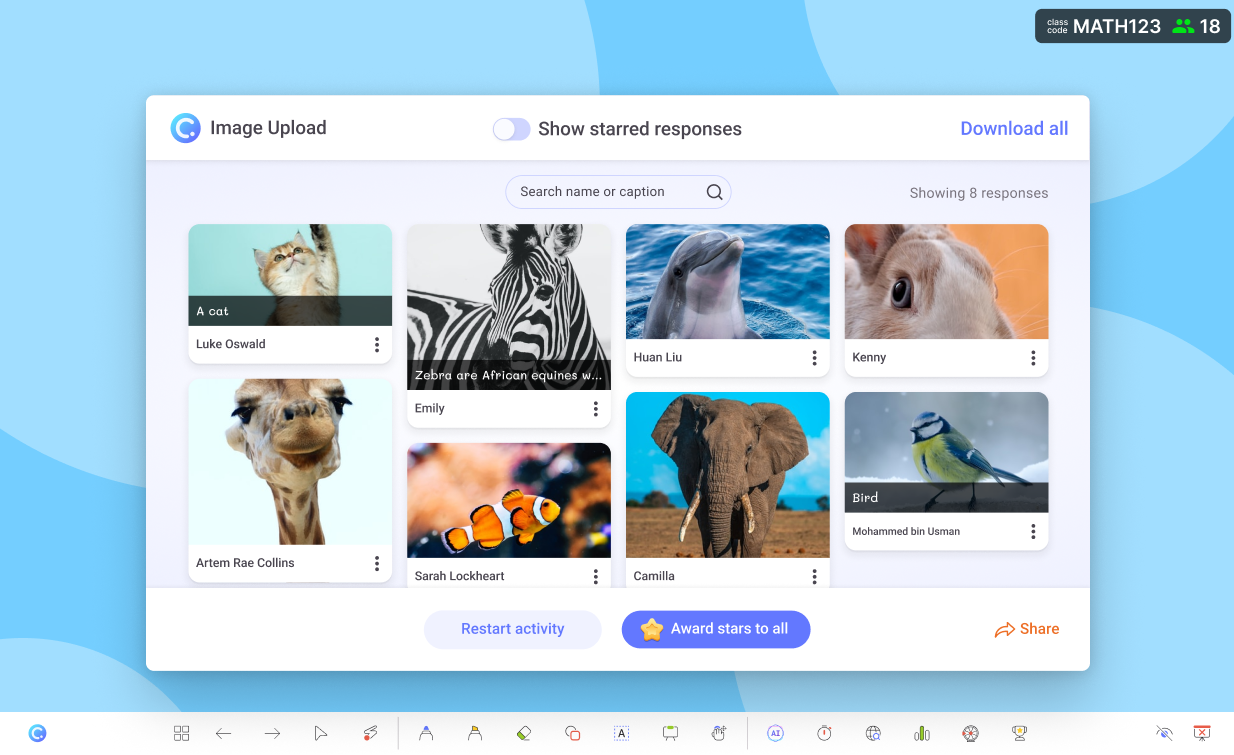
Image Upload allows students to share sketches, diagrams, or visual interpretations.
It supports brainstorming by having excellent visual thinking and encourages creativity and real-world connections.
To give you an idea on how to use image upload in a brainstorming session with students, refer to the table below:
| Brainstorm Goal | Student Image Submission |
|---|---|
| Invent a new household tool | Photo of a problem area in their house |
| Plan a garden layout | Screenshot of plant inspirations |
| Study ecosystems | Photo of organisms found in their neighborhood |
Pair Image Upload with ClassPoint's Annotation Tools to circle recurring patterns in uploaded images.
Slide Drawing
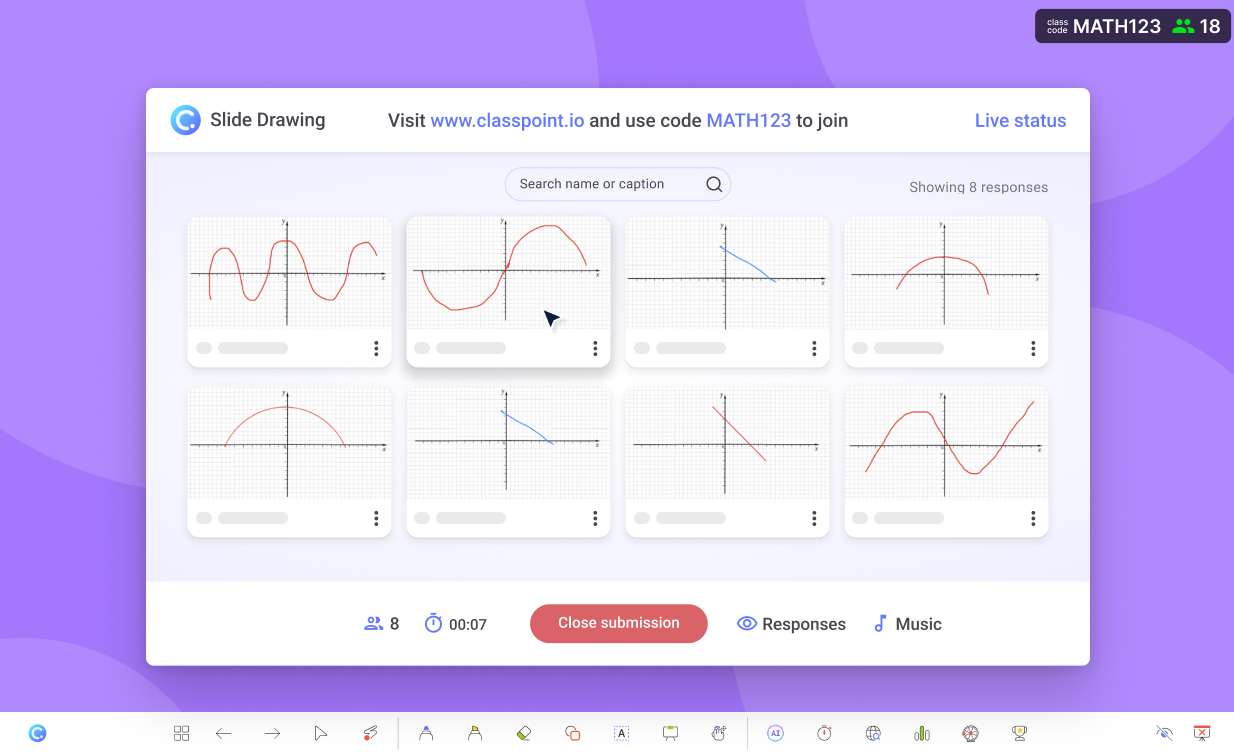
Slide Drawing is perfect for mind maps, charts, and collaborative annotations.
It has many uses for brainstorming activities. Some of them are:
- Mind Map Activity: Students can create branches, icons, arrows, and symbols.
- Quick Design Challenge: Students can draft simple visuals and compare.
- Problem-Solving Chart: Students can visually explain reasoning.
With these features, brainstorming becomes more interactive, inclusive, and seamless because everything happens inside PowerPoint. Teachers stay focused on guiding thinking rather than managing different tools.
FAQs
How often should teachers use brainstorming activities in class?
There is no fixed rule, but many teachers find it helpful to use brainstorming activities at the beginning of new units, before major projects, or anytime students need to activate prior knowledge. Even short, five-minute brainstorming tasks once or twice a week can strengthen creative thinking over time.
Can brainstorming activities work with very quiet or shy students?
Yes. Many brainstorming activities allow students to participate anonymously or through writing instead of speaking. Options like digital submissions, sticky note sharing, or silent brainwriting help hesitant students contribute without social pressure.
Are brainstorming activities helpful for assessment?
Indirectly, yes. While brainstorming is not a graded activity, the ideas students generate can reveal misconceptions, gaps in understanding, or areas where they need support. Teachers often use this insight to adjust lessons or create follow-up tasks.
How can teachers prevent students from dominating brainstorming discussions?
Use structures that guarantee equal participation, such as round robin sharing, time-limited turns, or digital submissions where every student has the same opportunity to contribute. Tools like random pickers can help keep participation balanced.
Can brainstorming activities be used for subjects like math?
Definitely. In math, brainstorming activities can be used for exploring problem-solving strategies, identifying multiple solution paths, generating real-world examples, or predicting outcomes before working through equations.
What should teachers do if brainstorming results in too many ideas to sort through?
Start by clustering similar ideas into categories, then narrow them down using criteria such as feasibility, clarity, relevance, or student interest. This helps transform a long list into a manageable set of strong starting points.
How can teachers keep brainstorming sessions from becoming chaotic?
Set clear guidelines before starting, use structured formats, and define the purpose of the brainstorm. Using visual anchors like charts, timers, or digital tools also helps maintain order and keeps students focused.
Can brainstorming activities help students with executive functioning challenges?
Yes. Structured brainstorming activities give students clear steps, visual tools, and low-pressure ways to generate ideas. This can support planning, organization, and flexible thinking, especially when paired with visuals or graphic organizers.
What is the best way to end a brainstorming session?
Close by summarizing the strongest ideas, clarifying next steps, and assigning tasks or follow-ups. Students should leave knowing how the brainstorm connects to the upcoming lesson, project, or inquiry task.
